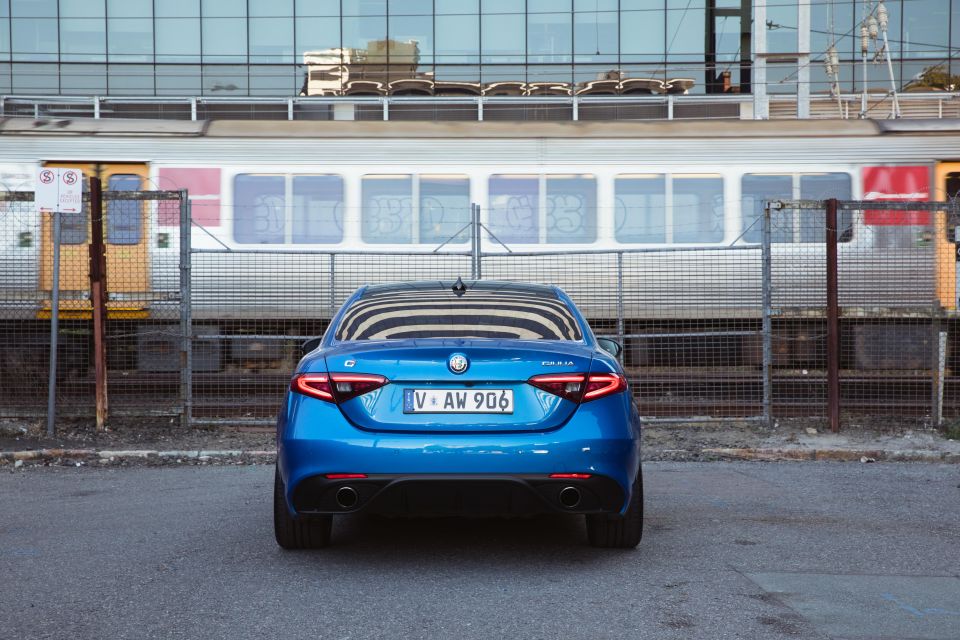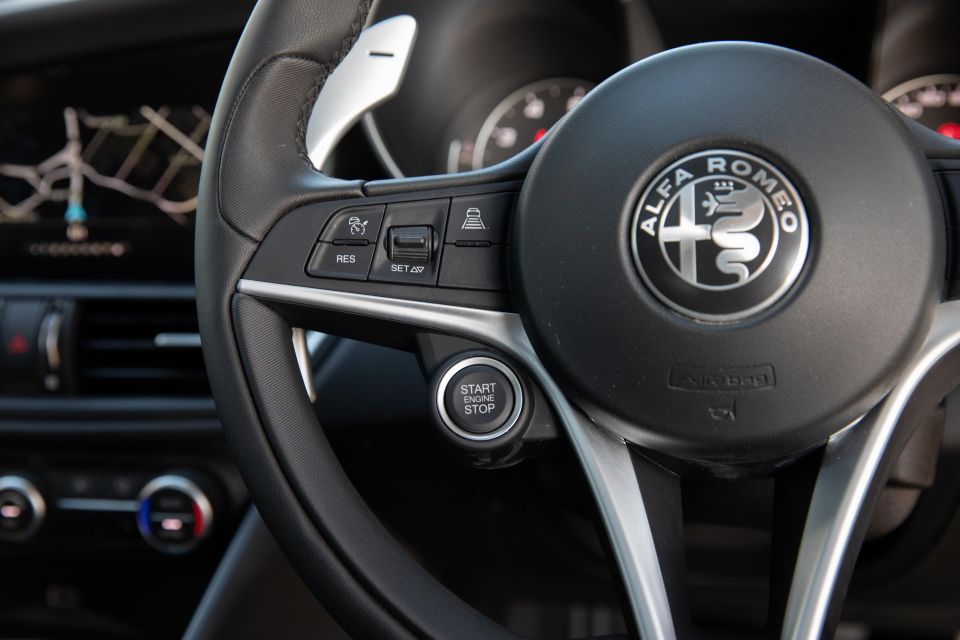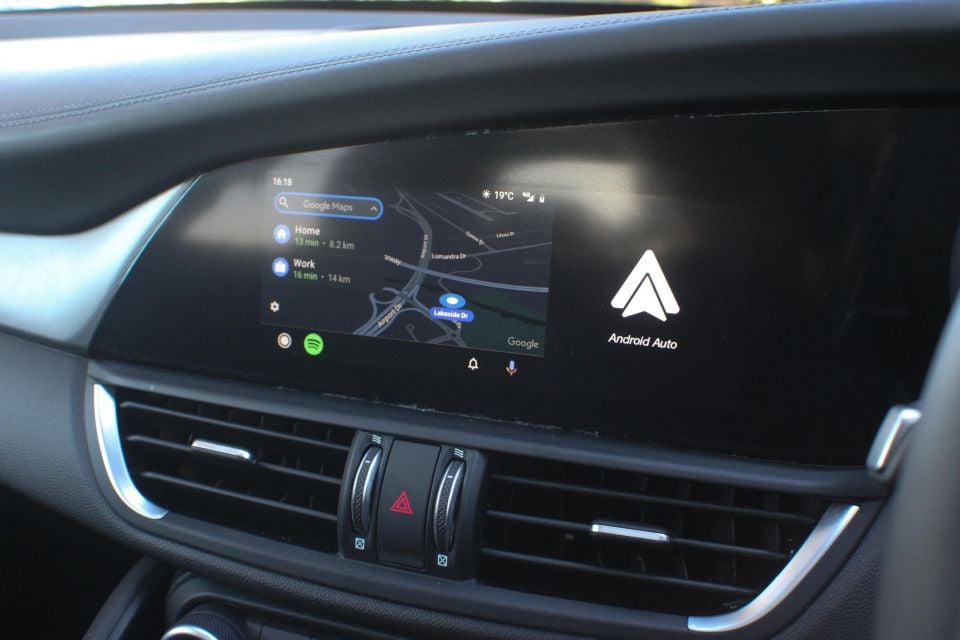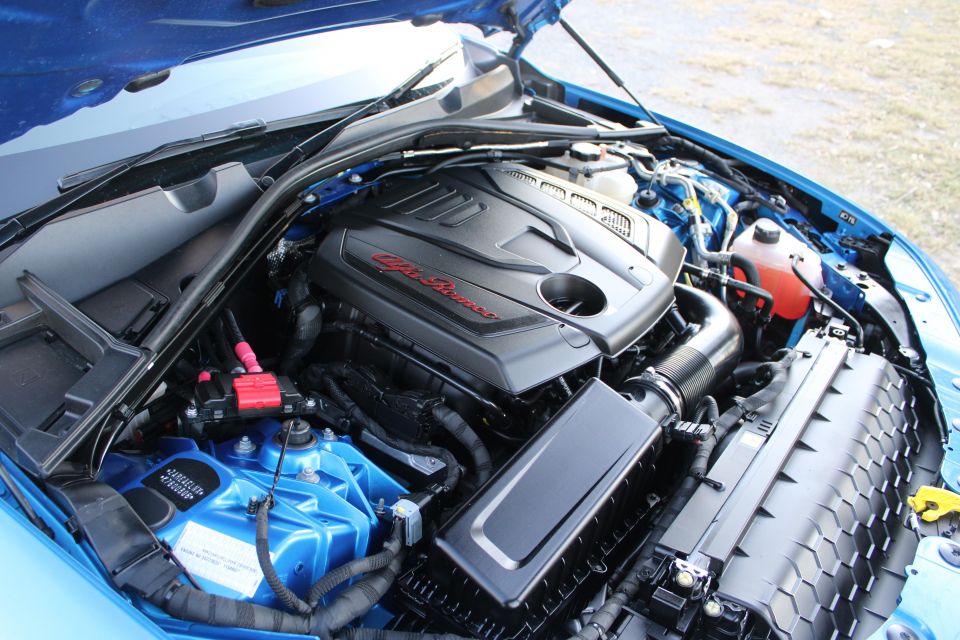

Damion Smy
Hyundai teases Staria EV ahead of likely January reveal
2 Hours Ago
While the BMW 3 Series and Mercedes-Benz C-Class are plusher and more comfortable than ever before, the Alfa Romeo Giulia feels like a genuine sports sedan in every aspect. That’s mostly a good thing.



News Editor
New from
$63,950
excl. on-roads

News Editor
New from
$63,950
excl. on-roads


News Editor
New from
$63,950
excl. on-roads

News Editor
New from
$63,950
excl. on-roads
Quickly see how this car stacks up against its competition. Select any benchmark to see more details.
Where expert car reviews meet expert car buying – CarExpert gives you trusted advice, personalised service and real savings on your next new car.
When Alfa Romeo announced it was introducing its first rear-wheel drive sedan since the 75 ended production in 1992, expectations were understandably high.
The 155, 156 and 159 models produced in the intervening years each had their strong suits and were infused with Alfa brio. Nevertheless, in this part of the market, rear-wheel drive is almost mandatory.
Fortunately for Alfa Romeo, its Giulia was met with almost universal critical acclaim upon its introduction in 2017. A few years have passed and there’s fresh competition, including a redesigned version of the BMW 3 Series, the car that set the template for this segment. So, how’s the Alfa holding up?


The Alfa Romeo Giulia range opens at $60,900 before on-road costs for the base model, simply called Giulia.
The Veloce featured here is priced at $72,900 before on-road costs, though Alfa is currently offering it for $72,900 drive-away.
It brings with it a more powerful version of the base Giulia’s turbocharged 2.0-litre four-cylinder engine. Its price pits it directly against the BMW 330i and Mercedes-Benz C300, which also feature more powerful versions of their cheaper counterparts’ turbocharged fours.
Metallic paint adds an extra $1300, which includes the drop-dead gorgeous Misano Blue of our tester, a compelling alternative to Alfa’s signature red. If it’s too flashy for you, there’s a more subtle, navy shade called Montecarlo Blue.
Tri-coat paint options – Trofeo White and Competizione Red – cost $3500.


Buy your new car without the stress. It's fast, simple and completely free.

Great service from Travis and team, second time I have used this business would not hesitate to recommend them to anyone
Craig C.
Purchased a Ford Ranger in Sunshine Coast, QLD
CarExpert helped Craig save thousands on his Ford Ranger, now let us save you on your next new car.
Find a dealThough it costs an extra $7000 over the Giulia Super, it’s worth the premium. Besides a more powerful engine, the Veloce adds hardware like adaptive suspension and a limited-slip differential.
Visually, the Veloce is distinguished from lesser Giulias by its gloss black exterior trim and its larger 19-inch alloy wheels which resemble those of the Quadrifoglio. Inside, there are unique front sports seats, a different steering wheel, and aluminium interior trim.
Alfa Romeo offers a Veloce pack for the base Giulia that adds all of these features bar the limited-slip differential, while the adaptive suspension is a standalone option for the Giulia Super.


Like the Giulia Super, the Veloce comes standard with an 8.8-inch infotainment system with Android Auto, Apple CarPlay and satellite navigation, as well as heated seats front and rear, a heated steering wheel, adaptive cruise control, and bi-xenon headlights with adaptive high beam and Alfa’s Adaptive Forward Lighting System.
As expected at this price point, there’s also a reversing camera, front and rear parking sensors, power front seats (eight-way for the driver, six-way for the passenger) and proximity entry with push-button start. An eight-speaker sound system is standard but a 14-speaker Harman Kardon system is optional.

The Alfa Romeo Giulia has a five-star safety rating from ANCAP, based on testing from 2016. It received a score of 98 per cent for adult occupant protection, 81 per cent for child occupant protection, 69 per cent for pedestrian protection, and 60 per cent for safety assist.
All Giulias come standard with autonomous emergency braking with forward-collision warning. The system works at speeds between 7 and 200km/h, though it can only detect and brake for pedestrians at speeds under 50km/h.
There’s also lane-departure warning (but no lane-keeping assist), blind-spot monitoring, rear cross-traffic alert, and front, front-side and curtain airbags.

The Giulia’s interior is classy and well-constructed but there are some annoying foibles. Fortunately, it appears some of these issues will be resolved in the upcoming refresh, revealed late last year.
The sides of the centre console are upholstered in leather-look trim, softer than that used on the dash top. Unfortunately, the console itself is mostly covered with easily stained grey plastic.
The rotary dial that controls the infotainment system is one of the interior parts you touch the most but it’s plastic, feels cheap, and can be rocked on its base.


The cupholders are positioned at the base of the centre stack – likely to make room for the dial – and that means any 600ml bottle you put in them will block some of the switchgear.
Then there’s the compartment on the centre console, which has a softly-padded but ultimately flimsy-feeling lid that managed to jam the fingers of two of my friends. Its lid can also be rocked on its hinge and was already showing wear on the inside from when it wasn’t closing correctly.


The lid conceals a compartment that’s tiny, which underscores a significant flaw with the Giulia’s cabin – there’s simply not enough storage. The bottle holders in the doors are puny, the glove compartment houses the manual and little else, and there’s nowhere to put your sunglasses.
While these flaws are all bothersome, the Alfa Romeo Giulia’s interior excels in some areas. The metal paddle shifters are magnificent and are mounted to the steering column and not the wheel. The front seats, too, are wonderfully grippy once you step down into them – the Giulia feels lower-slung than many sedans.
It definitely feels like Alfa Romeo was prioritising driving enjoyment over all-round practicality when it was designing the interior. That extends to the “DNA” drive mode selector, which is a proper dial on the centre console that stays in the mode you leave it in when you turn off the car.
The infotainment system can be controlled only via the rotary dial. In terms of functionality, it’s reminiscent of older versions of BMW’s iDrive. You can move the dial up and down to the side – moving it to the left, for example, takes you back a screen – and there are only two physical buttons.



Ultimately, the infotainment system works quite well. Even Android Auto works well for software that’s usually navigable by touch, and Google Maps’ navigation instructions actually appear within the instrument cluster. The factory navigation, too, is surprisingly good, with crisp, simple graphics and quick zooming.
Alas, the system isn’t perfect. Perhaps due to the screen’s dimensions, Android Auto appears quite small and oriented to the left, leaving a large chunk of dead space to the right. The reversing camera, too, is pathetically small so as to make room for a “map” of the car’s parking sensors which, inexplicably, doesn’t follow the same red-yellow-green pattern of systems in other cars. Instead, it’s all red.
The screen’s positioning with the centre stack is attractive, surrounded by black glass for a frameless look. That’s in stark contrast with, for example, the glued-on tablet appearance of the Audi A4 and Mercedes-Benz C-Class systems. Unfortunately, this means the screen isn’t the ideal size and some grit was already collecting at the edges of the glass panel.


The instrument cluster is elegant, with a 7.0-inch screen flanked by two large analogue dials. The only problem is the way the speedometer is oriented – 0km/h is located at six o’clock on the speedometer, which means the speeds you’ll actually be travelling at are given less visual priority than in other cars.
Luggage volume is 480L – identical to the 3 Series – and the rear seats fold 40:20:40.
If you’re around 180cm tall, you can sit comfortably in the back seat provided you don’t sit bolt upright. If you do, you’ll find your head brushing against the roof. There’s plenty of legroom, though, if you’re sitting behind someone similarly-sized, with the front seatbacks scooped out to aid knee room.


Back seat passengers also have a sunroof to themselves, the Giulia eschewing the increasingly common panoramic sunroof for one mid-sized opening up front and one tiny, fixed-glass one at the rear. There are vents and a single USB outlet for rear passengers plus seatback nets, though the bottle holders in the doors are just as useless as those up front.
There are some other foibles in the interior. The sunvisors, for example, are so small as to be virtually useless. The trip computer is navigated via a button on the end of the stalk that, in many other cars, would mist the windshield. The air-conditioning can also be a bit noisy.


If this seems like a litany of complaints, it’s worth noting the Giulia’s interior is handsome and feels befitting of a sports sedan. Other than the lid of the centre console bin and a piece of trim in the passenger footwell, build quality was also superb, down to the solid thunk of the doors.
The upcoming facelift addresses a significant number of these complaints. The infotainment system has been updated and adds touch functionality, its rotary dial is reportedly sturdier, the cupholders have been moved further away from the centre stack, and the centre console has been tidied up with nicer materials.

Like the base Giulia and Giulia Super, the Veloce uses a turbocharged 2.0-litre four-cylinder engine. However, its outputs have been bumped up to 206kW of power and 400Nm of torque, an improvement of 59kW and 70Nm and good for a 0-100km/h time of 5.7 seconds.
Power is sent to the rear wheels through a ZF-sourced eight-speed automatic transmission. While all-wheel drive is available in other markets, all Giulias in Australia are rear-wheel drive – this explains the Q2 badge on the boot lid.


Where expert car reviews meet expert car buying – CarExpert gives you trusted advice, personalised service and real savings on your next new car.
The only Giulia more powerful than the Veloce is the Quadrifoglio, but you’ll pay literally double the Veloce’s asking price for the privilege.
The Veloce’s outputs compare favourably with the similarly-priced BMW 330i and Mercedes-Benz C300. The BMW produces 190kW of power and 400Nm of torque, while the Benz produces 190kW of power and 370Nm of torque.
The Genesis G70 is the segment wildcard. In 3.3T Sport trim, it costs slightly less than the Veloce and features a twin-turbocharged 3.3-litre V6 with 272kW and 510Nm.


The Giulia Veloce definitely leans more to the sporty side of things. That’s not to say it’s unrefined. Quite the opposite: there’s virtually no wind noise, even at highway speeds, while tyre noise is kept to a minimum.
The adaptive suspension also softens out some of the roughest roads Brisbane has to offer, regardless of drive mode. Even at high speeds on cragged, pock-marked bitumen, the Giulia absorbed impacts without crashing and shuddering. The ride is firm, but it’s never uncomfortable.
Whereas in some cars a switch to sport mode is sometimes needed to add some zest to the throttle response and shift pattern, the Giulia’s default mode is already plenty sporty. Indeed, sometimes in more spirited driving it’ll hold a gear for slightly longer than you’d expect in a luxury sedan.
The sport mode in the Giulia turns up the wick even more and will frustrate you in urban driving, only because the car is ready and raring to be driven above urban speed limits.
Taken to the kind of twisty road it was designed for, the Giulia impresses. Again, normal mode is athletic enough but the sport mode is sublime. There’s oodles of grip, while the adaptive suspension keeps the Giulia hugging the road in corners. There’s a touch of oversteer in some bends but the Alfa always feels controllable and poised – you can definitely feel the near 50:50 weight distribution.
Winding roads also demonstrate the effectiveness of the Giulia’s Adaptive Front Lighting System, which redirects the beam of the headlights while cornering.
The savvy eight-speed torque-converter automatic is best left to its own devices. You can use those wonderful paddle shifters but the car will exit manual mode if you don’t make a shift for a little while.


The 2.0-litre sounds like what a turbocharged four-cylinder engine should sound like. Unlike some other boosted fours, it has character, it only occasionally sounds gruff, and it’s sonorous at full blast.
There’s so much talent here – a torquey, tractable engine and a superbly-balanced chassis – that it feels wasted on our speed camera and traffic-infested roads.
There were only a few issues on the road. On a couple of occasions – for example, slowing down to a stop and taking off again immediately – there was a delay as the Alfa hunted for the right gear.
The car will also sometimes ask you to press the electric park brake while pressing the brake pedal before you can move in reverse or drive, but other times you can take off without having to do this.
Also, the lane-departure warning chime is about as loud as the forward-collision warning chime, which seems like a surefire way to alarm your passengers. Fortunately, when you turn off the system, it defaults to off when you next start the car.


The same can’t be said for the auto stop/start, though it can be toggled on and off via a button to the right of the steering wheel. It’s a fairly unobtrusive system, however.
In a mix of city and highway driving, the Giulia averaged 11.3L/100km on 95RON premium unleaded fuel. If you include the 1000 or so kilometres done by the driver prior to me, the Giulia managed an average fuel economy of 10L/100km.
Suffice it to say, both figures are well off from the Giulia’s claimed 6.1L/100km on the ADR combined cycle. To get that kind of fuel economy, you’d have to put it into buzzkill eco mode and drive the Giulia like it isn’t a Giulia.
The Giulia requires servicing every 12 months or 15,000km, whichever comes first.
In addition to a three-year, 150,000km warranty – which pales against the five-year warranty offered by Mercedes and Genesis – Alfa Romeo offers five years of capped-price servicing, with services costing $345, $645, $465, $1065 and $345, respectively.


Past Alfa Romeo sedans like the 159 were brimming with flair but the driving experience, while decent, could never measure up to the best sports sedans Europe had to offer. The Giulia, conversely, offers all the flair you’d expect from an Alfa but with a terrifically balanced, rear-wheel drive platform.
The interior is lacking some attention to detail but, fortunately, the upcoming revision will remedy some of these woes.
The Giulia mightn’t be as practical or comfortable as some rivals but it’s fantastic to drive and brimming with character. For some of you, that just might be enough.
Where expert car reviews meet expert car buying – CarExpert gives you trusted advice, personalised service and real savings on your next new car.
William Stopford is an automotive journalist with a passion for mainstream cars, automotive history and overseas auto markets.


Damion Smy
2 Hours Ago


Damion Smy
6 Hours Ago


Damion Smy
7 Hours Ago


Damion Smy
7 Hours Ago


Damion Smy
8 Hours Ago


Josh Nevett
8 Hours Ago